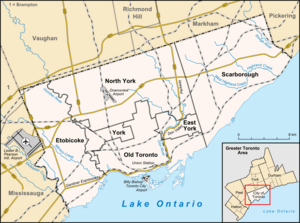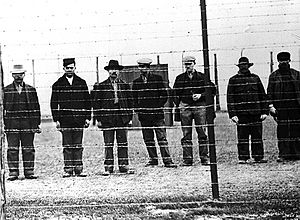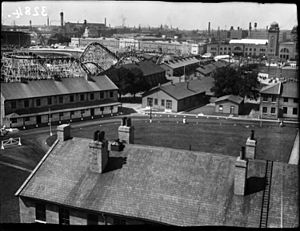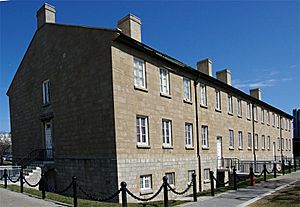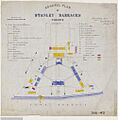New Fort York facts for kids
Quick facts for kids New Fort York |
|
|---|---|
| on the Garrison Reserve, west of Toronto Harbour in Toronto, Ontario, Canada | |
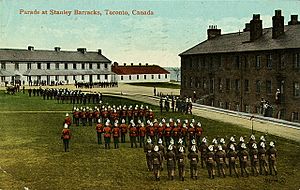
The Canadian Militia on the parade grounds of Stanley Barracks, c. 1910
|
|
|
Location in Toronto
|
|
| Coordinates | 43°37′59″N 79°24′49″W / 43.6329665°N 79.4136691°W |
| Type | Military base |
| Site history | |
| Built | 1840 |
| Materials | Queenston limestone, wood |
New Fort York, later known as Stanley Barracks, was a military base in Toronto, Ontario, Canada. It was built by the British and later used by the Canadian military. Located on the shore of Lake Ontario, it was constructed between 1840 and 1841. This new fort replaced the older Fort York as the main military base for the area.
Unlike the older fort, many buildings at New Fort York were made from strong limestone instead of wood. A protective wall was planned but never built. The British army used the fort until 1870. After that, the Canadian military took over. They used it to train soldiers for important wars like the Second Boer War, World War I, and World War II. It also helped train some of the first members of the North-West Mounted Police. The Canadian military stopped using the fort after World War II. Most of the fort was torn down in the 1950s. Today, only the Officers' Quarters building remains on the site.
Contents
History of the Fort
The British Era

When the British first set up defenses for York, Upper Canada (which is now Toronto), they created a special area for the military. This area was roughly bordered by today's Dufferin Street, Queen Street, Peter Street, and the lake.
Two large 18-pounder cannons were placed near the lake, just east of where the new fort would be. This spot was called the Western Battery. Its job was to protect the entrance to the harbour. During the War of 1812, in the Battle of York in 1813, these cannons were destroyed.
Over time, the wooden buildings at the old Fort York started to get old. The military realized they needed new places for soldiers to live. They were even renting private buildings in the town to house troops. To pay for a new fort, the government approved selling some of the military land in 1833. However, construction didn't start until after the Rebellions of 1837–1838. In 1839, approval was given to build a new fort that could hold 300 soldiers.
Around 1840, the Royal Engineers of the British Army built six stone buildings. The largest was the Officers' Quarters. This two-story building, made of Queenston limestone, cost a lot of money (19,000 pounds sterling). The fort also had two barracks for soldiers, a hospital, a stable for officers' horses, a storage building, an engine house, a gunpowder storage building, and a canteen. All these buildings were arranged around a large parade square. The first plan included strong walls around the fort. But to save money, a cedar picket fence was built instead. The idea was to add stronger defenses later, but it never happened. A road connected the old and new forts. It entered the new fort through an iron gate and passed under an arch in one of the barracks.
Even though living conditions were considered good for the time, winters were very cold. It was hard to keep water from freezing. In the 1850s, the number of British troops at the fort went down because many were sent to fight in the Crimean War. Numbers went up again in the 1860s during the American Civil War. By the 1860s, the new fort didn't have enough space. Some soldiers, like the 13th Hussars, had to stay in the nearby Crystal Palace exhibition building.
Transfer to Canada's Control
In 1867, three British colonies, including the Province of Canada, joined together to form the new country of Canada. In 1870, the British Army left the fort. The property was officially given to the Canadian Militia in 1871. For a while, the fort was mostly empty. Only a few military families lived there, and the Ontario Rifle Association used it for training. In 1874, the new North-West Mounted Police used the fort to train a group of new recruits before sending them to Manitoba.
In 1883, the Canadian government created its first permanent military force. This gave the fort a new purpose. After some repairs, the fort reopened in 1884. It became an infantry school and a base for the Regiment of Canadian Artillery, Company C. This group was later named The Royal Canadian Regiment (RCR). The RCR saw its first action the next year in the North-West Rebellion.
The fort had rifle ranges, which sometimes caused problems with boats and people passing by. Bullets would sometimes hit boats if they got too close. In 1887, two people were hit by bullets. Because of this, the Canadian military bought land for a new rifle range in 1889. This new range was west of Etobicoke Creek, near Long Branch.
In 1893, The Royal Canadian Dragoons moved to the fort. That same year, the fort was renamed Stanley Barracks. It was named after Lord Stanley of Preston, who had just finished his time as the Governor General of Canada. Lord Stanley is also famous for donating hockey's Stanley Cup. In 1894, the Dragoons performed their first "Musical Ride." This was a show where they rode horses in special patterns to music. The Musical Ride was a popular part of the CNE Grandstand show for many years. The Dragoons stopped performing it in 1940 when they became an armoured regiment.
Later in the 1890s, soldiers from the Dragoons and the RCR at the fort helped police the Yukon Gold Rush. Troops from both groups also joined British forces fighting in South Africa in the Second Boer War. Soldiers were offered better pay to fight in South Africa, which led to some soldiers leaving the fort without permission. In 1901, 46 men from the Dragoons and RCR deserted.
Transfer to the City of Toronto
In 1878, a large farming fair was held on the military land. The next year, the annual Toronto Industrial Exhibition, which later became the Canadian National Exhibition (CNE), started using the site. The City of Toronto leased the land for the CNE. As the CNE grew bigger each year, the City of Toronto wanted more and more of the military land.
The end of New Fort York as a military base began in 1903. The Canadian government and the City of Toronto made a deal. They agreed to transfer the lands of the Old Fort, the New Fort, and the fort's graveyard to the City of Toronto. The City promised to protect the Old Fort and the graveyard. They also agreed to let military activities continue until new facilities were built for the army.
During World War I, the fort's activities expanded into the CNE buildings. These buildings were used as winter homes for soldiers. (In summer, soldiers stayed at Long Branch.) The CNE still happened during this time. The barracks were also used to hold German, Austro-Hungarian, and Turkish citizens. These people were considered "enemy aliens" during the war. From 1914 to October 1916, up to 90 men at a time were held in the west privates' barracks. They were later moved to other places. Before the war ended, many were released after promising to be loyal to Canada and report regularly to the police. Ukrainians, who were then part of the Austro-Hungarian Empire, were also held in the barracks. In 1998, the Ukrainian community in Toronto placed a plaque at the Officers' Quarters to remember this time.
In the 1920s, the CNE continued to grow, taking up more of the fort's land. The CNE asked the City of Toronto to tell the military to leave. A new road, Princes' Boulevard, meant some of the Barracks' buildings had to be torn down, including some stables and the riding school. The military was offered space for horses in the buildings used for livestock. A compromise was reached: new stables were built, and the military was allowed to use the Coliseum and Livestock arenas.
During World War II, the fort and many nearby exhibition buildings were again used by Canadian troops. Soldiers stayed there before being sent overseas. The Coliseum was used by the Royal Canadian Air Force. The Royal Canadian Artillery used the Dominion Government Building. The Horse Palace housed the 48th Highlanders, Toronto Scottish, Royal Canadian Ordnance Corps, and a company of the Royal Canadian Regiment. Other buildings used included the General Exhibits Building, the Graphic Arts Building, and the Horticultural Building. The dressing room of the Grandstand was used for anti-gas training. The annual CNE still took place in 1939, 1940, and 1941, focusing on the war effort. Some military buildings were even open to the public during the CNE. The CNE was not held from 1942 to 1945. The CNE Camp was used to help soldiers return home after the war. It closed on June 1, 1946.
After World War II, the military moved out of Stanley Barracks. They went to a military base at Long Branch. The Royal Canadian Dragoons had already moved to Camp Borden in 1941. The CNE announced plans to tear down the fort and build a new public hall. However, these plans were put on hold because Toronto had a housing shortage. The Canadian government paid half the cost to turn the fort's buildings (there were 31 at the time) into emergency housing for civilians. The military kept its detention center for a short time. The housing was in very poor condition. It started closing down in 1950 and was empty by 1951. Demolition of the wooden buildings began in 1951, even while families were still living in the barracks.
By September 1951, only four stone buildings remained: the officers' quarters, the hospital building, and the two soldiers' barracks. People in the community wanted to save the Barracks and turn it into a museum. Governor-General Vincent Massey also supported keeping the stone buildings. But in 1953, three of the last four buildings were torn down to create parking for the CNE. The last building, the Officers' Quarters, was almost torn down too for more parking. In 1957, the Toronto City Council saved it from demolition.
The large iron gates to the barracks, made in England in 1839, were saved in 1957. They were moved to the Guild Inn in Scarborough. The gates were put up again in Toronto on Kingston Road at Guildwood Parkway. They are still there today at the entrance to Guildwood Village. Lights replaced the stone globes on top of the gate posts.
On November 11, 1963, a special plaque was put up near the Officers' Quarters to remember the fort. Many military groups and important people attended the ceremony.
In 2004, there were plans to build a hotel and conference center on the fort site. During an archaeological dig, the foundations of the old stone buildings were found. The City of Toronto decided not to build on the fort site. Instead, a nearby building was turned into a conference center. The hotel was moved to the east of the fort site. The old foundations were to be preserved. The new Hotel X Toronto project next to the site has shown the barracks' foundations. An entrance to the hotel is shaped like the old soldiers' barracks. Inside, you can see the uncovered foundations through a glass floor. The old parade ground is now a beautiful landscaped area.
Many military groups from the British Army and the Canadian militia stayed at the fort, including:
- Royal Canadian Rifles
- Seventy-First Highland Light Infantry
- Royal Artillery
- Thirteenth Hussars
- Canadian Permanent Force
- C Company of the School of Infantry, now The Royal Canadian Regiment
- B Squadron, The Royal Canadian Dragoons
The Officers' Quarters Building
The Officers' Quarters is a two-story building designed in the Georgian style. It has a full basement and attic. Its thick walls are made of Queenston limestone, and it sits on a Kingston limestone foundation with a dry moat around it. The original roof was made of slate tiles but was later covered with metal. The north side of the building was the front, facing the parade ground. The south side looks exactly the same as the north side. The building was set up so that two-thirds of the space was for the officers, and one-third was for the Barracks' Master.
Since 1955, the Officers' Quarters building has been home to different museums. These include Canada's Sports Hall of Fame, the Hockey Hall of Fame, and the Marine Museum. From 1955 to 1957, Canada's Sports Hall of Fame and the Hockey Hall of Fame shared space here. The Officers' Quarters housed the Marine Museum from 1959 to 1998. The museum then moved to Harbourfront but has since closed. The Officers' Quarters has been empty since 1998. It was opened for one weekend in May 2006 during Doors Open Toronto.
While the building was home to the Marine Museum, the grounds around it displayed two items from Toronto's history. The tugboat Ned Hanlan was on display on the west side of the building until 2012. Canadian National locomotive No. 6213 was located on the east side from 1960 until 2009.
In 1999, the Toronto City Council named the Quarters a Landmark Heritage Property. This means it's a very important historical building. In 2009, City Council approved building a hotel on the property, just east of the fort's site. The old parking lot north of the Officers' Quarters is now a plaza. South of the building is a garden used for outdoor events. The old shoreline of Lake Ontario is marked on the pathway paving near the Quarters. The outside of the building is being restored, but what the building will be used for next is still undecided.
According to author Richard Palmisano, the Officers' Quarters has two ghosts. One is a little girl looking for her cat, and the other is the girl's father. The building has even been part of a ghost walking tour on the Exhibition grounds.
Images for kids
-
The Royal Canadian Dragoons was one of several Canadian army groups stationed at the Fort.
-
German prisoners of war held in Stanley Barracks during World War I.


